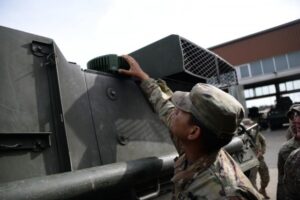The Army said Monday it has approved the Abbreviated Capability Development Document (A-CDD) to begin going after new Navigation Warfare Situational Awareness (NAVWAR-SA) capabilities, with plans to test prototypes later this year.
The signing of the A-CDD allows the Army’s Assured Positioning, Navigation and Timing (PNT)/Space Cross-Functional Team (CFT) to begin rapid experimentation of technologies to “detect, identify and locate sources of interference that deny or degrade reception of PNT.”

“This A-CDD will enable us to accelerate critical NAVWAR technology development and streamline the process of expediting an operationally relevant system to our warfighters,” Willie Nelson, director of the Assured PNT/Space CFT, said in a statement. “This capability will enhance our ability to provide real-time situational awareness of PNT reliability to soldiers and commanders on the battlefield, which will enable Long-Range Precision Fires and support freedom of maneuver of large scale ground combat operations.”
Rapid experimentation efforts will be used to test potential NAVWAR-SA capabilities and inform future requirements, with plans to assess prototypes at the Project Convergence ‘21 event later this fall and the CFT’s annual PNT Assessment Exercise at White Sands Missile Range in New Mexico.
“The APNT/Space CFT will utilize the ‘buy, try, and decide’ process to accelerate the development of critical enabling technologies and streamline the process of transitioning a scalable, interoperable and agile capability to the field,” the Army wrote in a statement.
The new A-CDD details the operational need for new capabilities to “‘sense’ the PNT environment in real-time, allowing commanders and units to maneuver with confidence and with precision when the global positioning system is degraded or denied,” according to the Army.
“[NAVWAR-SA] is intended to validate PNT signal integrity and provide users with indication and warnings of the presence and intensity of interference,” the Army wrote in a statement. “NAVWAR-SA will also characterize the operating environment through the integration of multiple sensors that are able to detect, identify, and geo-locate sources of intentional and unintentional interference.”